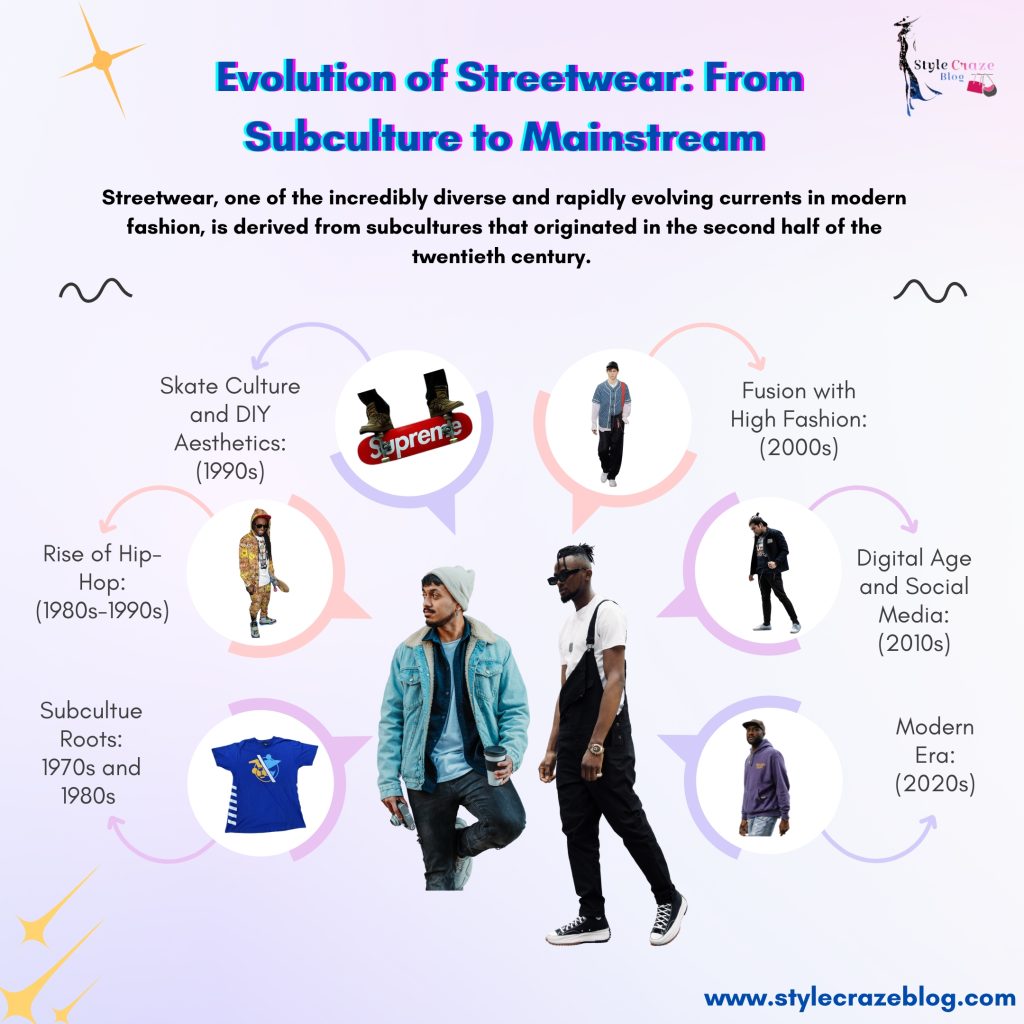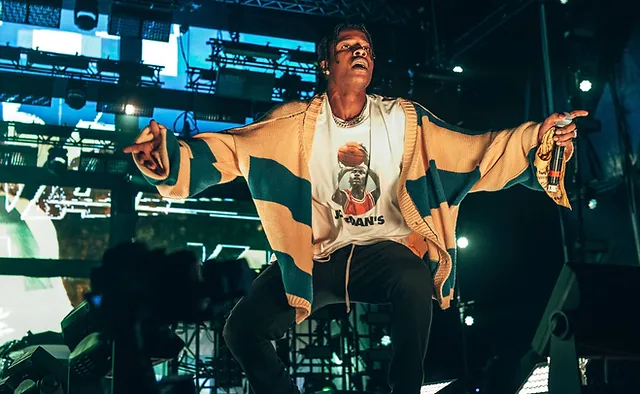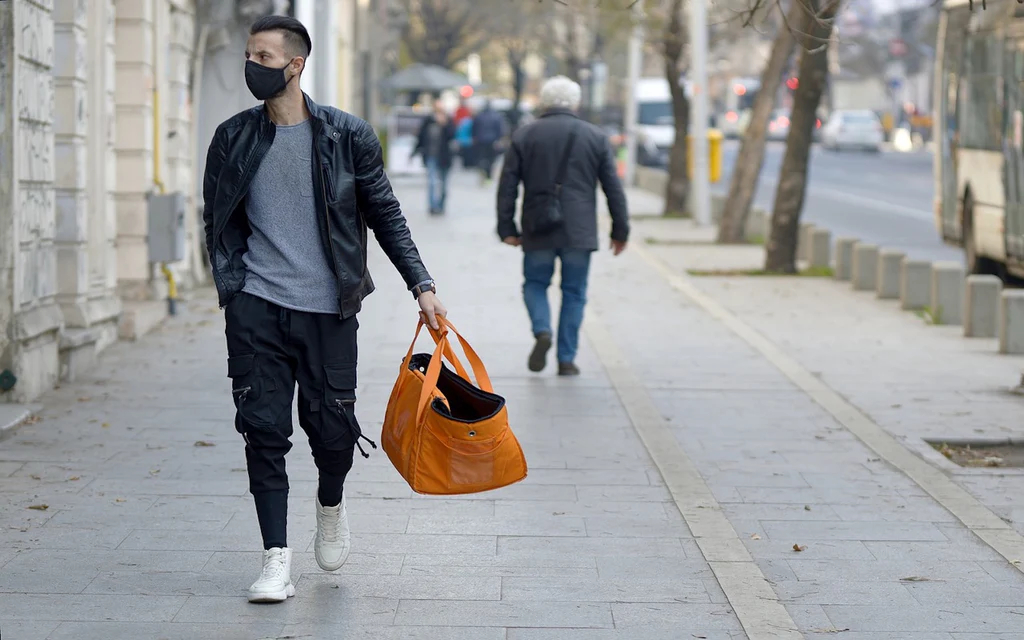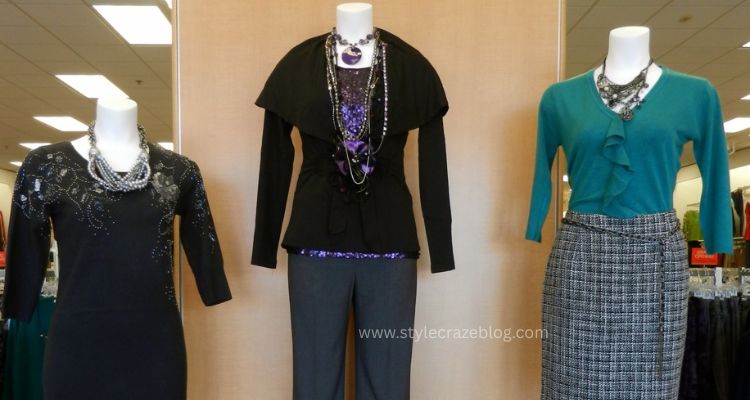Streetwear, one of the incredibly diverse and rapidly evolving currents in modern fashion, is derived from subcultures that originated in the second half of the twentieth century. What started as a small contingent of Y2K is now an all encompassing global trend in high fashion, streetwear and pop culture alike. So this blog post will take you through a fascinating ride by telling the story of how streetwear started from such a tiny niche and turned into one of the biggest forces in fashion today.
The Origins: 1970s and 1980s
Streetwear born from the notions of Southern Californian surf and skate culture in the 1970s and early ’80s. “The brands, like Stüssy [named after founder Shawn Stussy], were some of the first to really get that mentality across through clothing,” Fløyen says. Those T-shirts could be found hanging off the backs of every board wielding, graffiti vandalizing fashion junkie after who doorways of streetwear had opened. Sure, some of the early designs were a bit elementary, but they had an insouciant coolness that is still hard to beat for those that helped make them popular – surfers and skateboarders.
The Rise of Hip-Hop: 1980s to 1990s
Explaining in detail the emergence of rap and hip-hop as an integral part of music during the following period: since 1980s Changes Brough to society c. pV to 1990 t.
- Hip-hop in the late 1980s and into the 1990’s was integral to streetwear as it is known today Artists like Run-D. The impact of hip hop was not limited to music and there were fashion icons who established themselves through M.C., LL Cool J and the. Beastie Boys -Adidas tracksuits, Kangol hats and chunky gold chains were all associated with the era. So brands like FUBU (For Us By Us) began to crop up, specializing in streetwear that was much more explicitly aim at the African American community from which the relationship between hip hop and street wear would become solidified.
Chris Reid speaking about Skate Culture and DIY Aesthetics: 1990s
A resurgence skate wise in the 90’s saw a flourishing of streetwear culture with a hellishly hands on approach to boot. “Independent skate brands, like Supreme (who was founded by James Jebbia in 1994) started to appear.” Combined with Supreme’s strategy of quick strikes and availability limited to select releases (known as “drops”), along its intersecting work with artists, designers and other brands, it created a level of scarcity. One other trend worth mentioning that also contributed to punk and grunge’s influence during this time, is checker fabrics. Again not only as part of a prints explosion but more commonly in baggy jeans with oversized airwalks sneakers. graphic tees and a bunch of flannel shitts
Fusion of High Fashion: 2000s
So unsurprisingly the first real change appeared round again in the early 2000s when street wear made nice with none other than high fashion. The west coast style that spread from skateboarding, punk and hip hop cultures soon made in ways to the east coats runway shows through designers like Marc Jacobs as well as labels such Louis Vuitton. (Spencer Lowell / For the Los Angeles Times) Yet as streetwear brands proliferated, so, too did collaborations between those upstarts and luxury houses, worlds that were once distinct starting to blur. But nothing has seemed to crystallize that reality like the 2017 partnership between Louis Vuitton and Supreme, a watershed cultural and business event in which streetwear was embraced by high fashion, even as it continued to be co-opted.

2010s: Digital Age and Social Media
Social media changed everything The 2010s was the decade that social media went entirely, if you could consider it to be past its front-running stage and its effect on streetwear equalled streaming services in music. Meanwhile, Instagram (and especially tumblr!) were our other keys to marketing and developing our brand voice. Influencers and celebrities played a major role in driving streetwear, which also brought popular culture into the mainstream of this category. whereas it used social media to build that hype, as did Off-White (founded by the late visionary Virgil Abloh), which also achieved significant success in streetwear throughout this period of time. Proof is also there for Off-White, who’s quotation mark design and industrial-like designs symbols some of the best ways a digitally-powered generation can contribute towards this culture.
The Modern Era: Inclusivity and Sustainability
In 2020, streetwear has even taken its stand for inclusivity and a broader train of thought in terms of sustainability. Well next to that, does the brand ever seem to give a shit about the planet (and ceaselssly asking their racist followers why there are so few black models?) Eco-friendly streetwear-focused companies such as Pangaia and Patagonia try to produce clothing that won’t harm the environment, even if that means using low-impact materials in their manufacturing processes. Moreover, modern streetwear can actually be quite inclusive — with brands promoting different cultures or even the new designers of women’s and other body positive wear.
Streetwear’s Global Footprint
Global Reach: It doesn’t matter where you live or what your culture is, streetwear has reach and influence all over the world. Global cities, from Tokyo to Paris and London, are now heavily involve in the streetwear cultural story, with all of this combining a recipe into one melting pot and each city throwing in its ingredients. Japanese brands also achieved international renown, with A Bathing Ape (established in 1993) being one of the most visible examples. Nigo sold 22 percent of his company to Hong Kong businessman C.I. Kim for $3 million. [citation needed] “We think that in Europe, several brands and we are fascinate by London-based Palace Skateboards specifically have revolutionized global streetwear,” the designers added.

Key Elements of Streetwear
Streetwear is generally thought to be comprise of several key components, including:
Graphic Tees: They’ll always be a classic. safely speaking to the legions of fans, daring and at times outlandish graphics on t-shirts aren’t going anywhere. Such designs often encompass elements of cultural critique, artistry and a brand’s representation on the whole.
Sneakers: sneaker is arguably the most important thing defines streetwear Its proliferation of limited-edition releases, link-ups with innovative designers and creations that fetch hefty resale sums have transformed sneakers into both an economic juggernaut and a cultural touch-point.
Caps: snapbacks to beanies, headwear is an essential accessory in streetwear, and can also be a great piece for some branded or limited edition prints
Hoodies and Sweatshirts: They are often designs with bold logos and graphics as a canvas for individual self-expression.
Baggy Clothing: From skate culture to hip-hop, baggy clothing is still very in style. There’s a laid-back and cool vibe that this effortlessly achieves.
The Future of Streetwear
Sustainable fashion as streetwear — sustainable, eco-conscious clothing to become a trend in the increasingly environmentally conscious global society.
For instance, sustainability will play a larger part in the streetwear landscape, with more and more consumers becoming exposed to environmental issues. “Going forward there is going to be more of a focus on environmentally friendly materials, ethical production and manufacturing – also reducing our carbon footprint when creating goods,” she says.
Tech Integration with wearable tech, and smart fabrics among others; will be a new horizon in streetwear.
Trends like this one are so great for customization. Such a solid example of creating custom pieces and how people can express their attitudes and values from something that is root in streetwear.
Cultural fusion: Different cultural elements will more likely be integrate into streetwear which in the long run broadens and diversifies even further our fashion landscape.
Conclusion
Long gone are the days when streetwear was firmly root in southern California’s skate and surf culture. Over the subsequent decades, street style would feed into and off hip-hop culture, punk avant-gardism and high fashion. Today it is a powerful global phenomenon that shapes more than just our choice of clothing – but also the messages we want to send out to those around us. However, as streetwear matures and changes it will no doubt begin to reflect the cultural, social, and environmentally concerns of the day while at its roots continuing remain a fierce element in discussions about fashion. Given the nature of streetwear’s evolution, we think that whether you’re a long-time street veteran or just getting to grips with it all, there’s a road here that will be worth piquing your interests.




